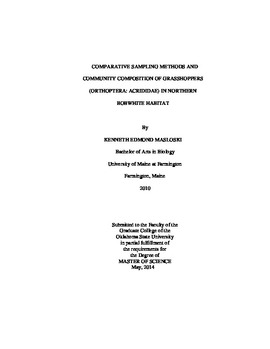| dc.contributor.advisor | Mulder, Philip | |
| dc.contributor.author | Masloski, Kenneth Edmond | |
| dc.date.accessioned | 2015-06-17T20:06:52Z | |
| dc.date.available | 2015-06-17T20:06:52Z | |
| dc.date.issued | 2014-05-01 | |
| dc.identifier.uri | https://hdl.handle.net/11244/14986 | |
| dc.description.abstract | This research contributes to a larger body of work concerning the decline of Northern Bobwhite in Western Oklahoma. Populations of Northern Bobwhite have been declining since at least the 1960's. Previous research has demonstrated that arthropods are essential to the diet of these birds. This resource provides protein to egg-laying hens that aids in producing eggs of better quality and to brooding chicks that aids in development of feathers and flight muscles. Grasshoppers (Orthoptera: Acrididae) are among the preferred arthropod prey for these birds. The objectives of this study were to compare standard methods of grasshopper sampling with a novel method and to characterize the community of grasshoppers in Northern Bobwhite habitat. Relative abundance as determined by sweep net sampling and density of grasshoppers observed in ring sampling was compared with a novel method of sampling that simultaneously measured relative abundance and number of grasshoppers caught per minute. Relative abundance estimates were not comparable between sampling methods, and density and rate of grasshoppers caught were positively correlated. Coefficients of similarity were calculated to show how similar measurements for abundance and richness were between sweep net and the novel sampling method. Community composition data were taken from sweep net samples. Proportions of functional group cover (components of vegetative make-up) were sampled using modified Daubenmire frames simultaneous to sweep net sampling. Abundant grasshopper taxa changed between vegetation types. Grasshopper subfamilies were also positively correlated with different functional groups. Factor analysis data show that grass and forb cover (as determined by modified Daubenmire frame sampling) were more important than litter and bare ground cover in predicting subfamily distribution. Simpson's diversity indices showed that grasshopper diversity increased over time and that upland sites were more diverse than any other vegetation type. This study was able to determine the effectiveness of standard and novel sampling methods and characterize grasshopper communities in Northern Bobwhite habitat and provides implications for management and further study of this system. | |
| dc.format | application/pdf | |
| dc.language | en_US | |
| dc.publisher | Oklahoma State University | |
| dc.rights | Copyright is held by the author who has granted the Oklahoma State University Library the non-exclusive right to share this material in its institutional repository. Contact Digital Library Services at lib-dls@okstate.edu or 405-744-9161 for the permission policy on the use, reproduction or distribution of this material. | |
| dc.title | Comparative Sampling Methods and Community Composition of Grasshoppers (Orthoptera: Acrididae) in Northern Bobwhite Habitat | |
| dc.type | text | |
| dc.contributor.committeeMember | Greenwood, Carmen | |
| dc.contributor.committeeMember | Giles, Kristopher | |
| dc.contributor.committeeMember | Elmore, Dwayne | |
| dc.contributor.committeeMember | Payton, Mark | |
| osu.filename | Masloski_okstate_0664M_13277.pdf | |
| osu.accesstype | Open Access | |
| dc.description.department | Entomology | |
| dc.type.genre | Thesis | |
| dc.subject.keywords | acrididae | |
| dc.subject.keywords | ecosystem | |
| dc.subject.keywords | grasshoppers | |
| dc.subject.keywords | grassland | |
| dc.subject.keywords | northern bobwhite | |
